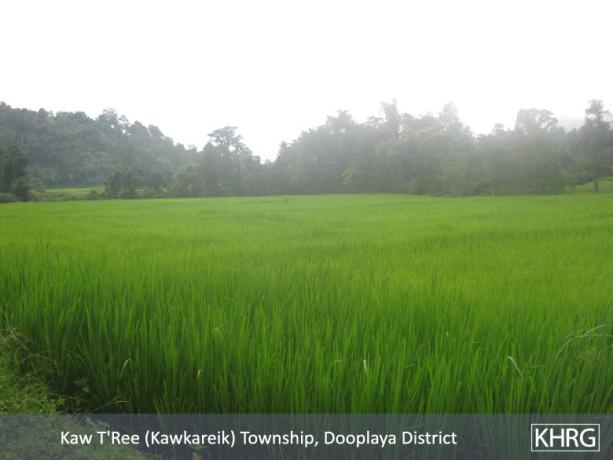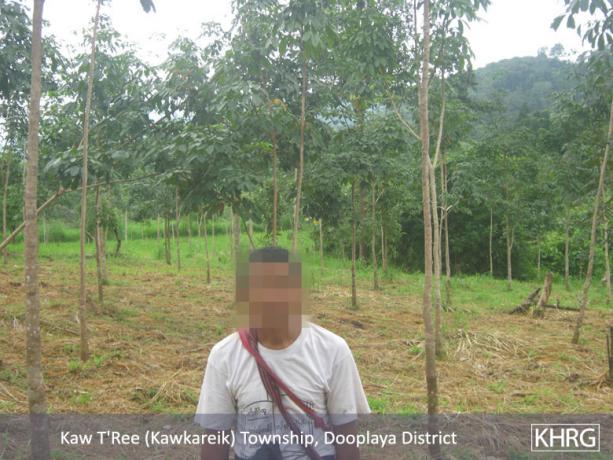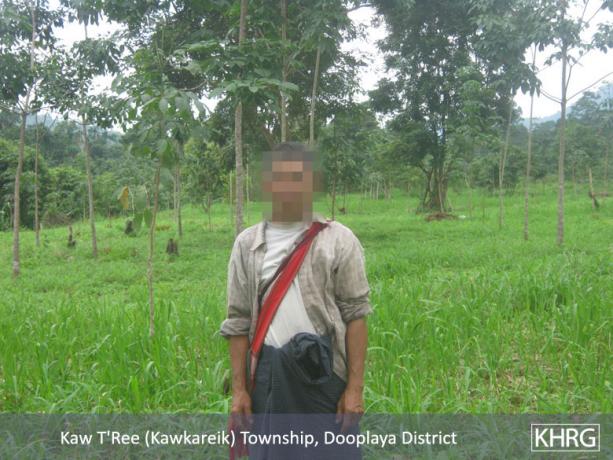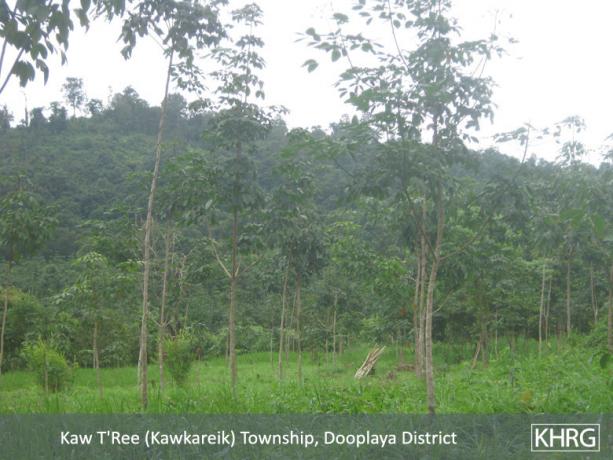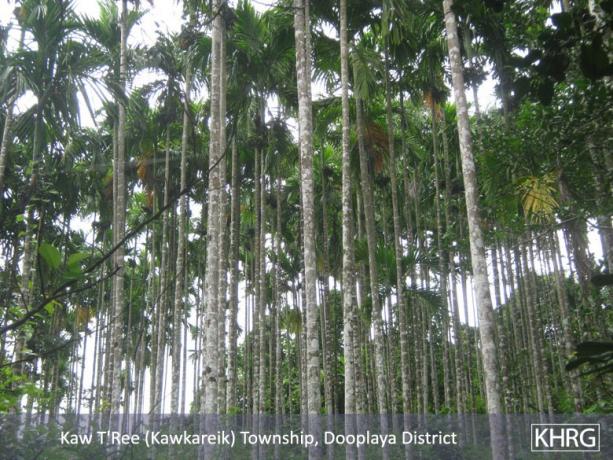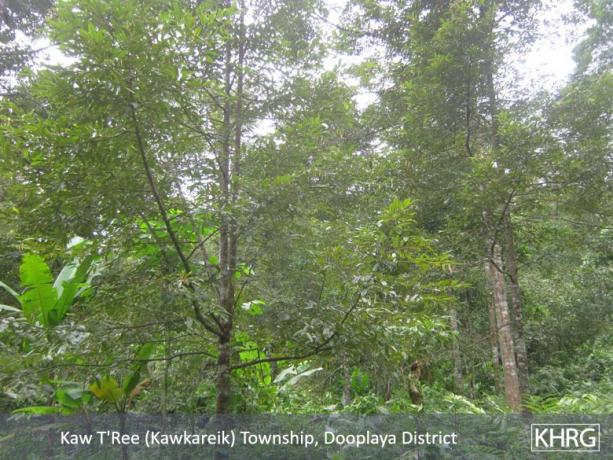In September 2011, residents of Je--- village, Kawkareik Township told KHRG that they feared soldiers under Tatmadaw Border Guard Battalion #1022 and LIBs #355 and #546 would soon complete the confiscation of approximately 500 acres of land in their community in order to develop a large camp for Battalion #1022 and homes for soldiers' families. According to the villagers, the area has already been surveyed and the Je--- village head has informed local plantation and paddy farm owners whose lands are to be confiscated. The villagers reported that approximately 167 acres of agricultural land, including seven rubber plantations, nine paddy farms, and seventeen betelnut and durian plantations belonging to 26 residents of Je--- have already been surveyed, although they expressed concern that more land would be expropriated in the future. The Je--- residents said that the village head had told them rubber plantation owners would be compensated according to the number of trees they owned, but that the villagers were collectively refusing compensation and avoiding attending a meeting at which they worried they would be ordered to sign over their land. The villagers that spoke with KHRG said they believed the Tatmadaw intended to take over their land in October after the end of the annual monsoon, and that this would seriously undermine livelihoods in a community in which many villagers depended on subsistence agriculture on established land. This bulletin is based on information collected by KHRG researchers in September and October 2011, including five interviews with residents of Je--- village, 91 photographs of the area, and a written record of lands earmarked for confiscation.[1]
On September 26th 2011, villagers from Je--- village, Kawkareik Township, Dooplaya District told KHRG that they face an urgent threat of land confiscation by Tatmadaw Border Guard Battalion #1022 led by Bu---, and Light Infantry Battalions (LIBs) #355 and #546 under Tatmadaw Military Operations Command (MOC) #12. According to the Je--- residents, their village head was informed in May 2011 that the Tatmadaw will develop a 500-acre tat nan myay [a military area or military zone] in Je--- for Border Guard Battalion #1022, which is currently based in Tu---. The village head then met with villagers whose existing agricultural projects were located in the intended project area, and informed them that their lands would be expropriated to make way for the tat nan myay, which would include the construction of a base, supply depot, and homes for the families of Tatmadaw Border Guard soldiers.
"The first time they came to measure, it was nine [paddy] farms. They didn't want to collect [survey] the betelnut plantations because there were too many. The betelnut fields and durian fields were about 20 or 30 fields…There is one more rubber field but, as I told you, she [the owner] didn't come [to the interview location]. The man who came with me, his rubber plantation is very big, but when the SPDC[2] government goes to take it, they will take it all… I plant once every three years. From three years ago I planted 2,000 plants, and this year I planted more 1,000 plants, so in all there are 3,000 rubber plants… The operation commander came to see village head, and the village head called us let us know… They'll build up both an army camp and their houses, and the battalion…When they come to base here, their families and children will follow and come to stay with them."
- Saw Ca--- (male, 45), Je--- village, Kawkareik Township (September 2011)
"The Border Guard and the SPDC Army [Tatmadaw] came together. The Border Guard commander is named Bu--- but the SPDC commander, I don't know his name. The [Tatmadaw] Battalion was #355… They said they'll build the place for the Border Guard… They didn't take [our land] yet, but they're concentrating on it. They said they'll build up their place, and they came to order the village head to tell the villagers [they would] take the lands. They think if the village head can take it [the land] it'll be peaceful."
- Saw Do--- (male, 60), Je--- village, Kawkareik Township (September 2011)
The villagers that spoke with KHRG said that they had not seen a written order that their land would be confiscated, but that they believed the order to be real, and urgent. At least two interviewees reported that, in the meeting, the village head told rubber plantation owners whose land would be expropriated as part of the planned tat nan myay, that they would be paid compensation of 10,000 kyat (US $12.05)[3] per tree on their plantations. The villagers expressed concerns that other types of land would be taken, but did not know whether compensation would be paid to farmers who have betel or durian plantations, paddy fields, or fallow agricultural land.
"I heard the one time the village head told us they'll give [compensation]. For one rubber plant they'll pay 10,000 kyat… If they pay for the plants, that also includes the land [cost] too… Along the lake we have durian plantations, betelnut plantations and dog fruit plantations. The villagers plant many things in that area."
- Saw Ca--- (male, 45), Je--- village, Kawkareik Township (September 2011)
"If they take it, we can't do anything. We just have to give it to them… If they take it, we won't have a place to live… [Now] They'll only take the rubber [plantation] lands but I see, in the future, if they get those places [then] they'll take more and more land."
- Saw Do--- (male, 60), Je--- village, Kawkareik Township (September 2011)
The interviewees further reported that government officials measured lands under cultivation along the vehicle road in the Mi--- area of Je--- village immediately after the order was issued through the village head in May 2011, and once more in the second week of September 2011; the soldiers and government officials also photographed the land owners. One source also explained that the Tatmadaw attempted to survey the area in 2010, but clashes with soldiers from Karen National Liberation Army (KNLA) prevented them from doing so, although an access road to the area was surveyed and cleared in 2010
"They came before the rainy season, in the water festival month. The first time they came to measure the lands was in 2010… I think they were SPDC staff [the first time], because they were ordered by the SPDC government… The second time SPDC government staff [also] came to measure the lands… They took pictures of us. Before they called the villagers, they already sent down their soldiers to the places… There were 100 soldiers."
- Saw Do--- (male, 60), Je--- village, Kawkareik Township (September 2011)
"If the KNLA hadn't been there, they already planned to do this [take villagers' land] once last year… The group that came to measure the area is called 'Ha Sha.' The ones who came to measure the road were Thai… The Thai people came and hired us to clear the road. They paid 4,000 kyat per day. Now they're gone, and later the SPDC government came."
- Saw Ca--- (male, 45), Je--- village, Kawkareik Township (September 2011)
According to the villagers that spoke with KHRG, the lands surveyed in May and September 2011 include at least 167 acres of productive and established agricultural land belonging to 26 villagers, and those villagers have been informed that they will have to give up their land. The table below details the acreage and types of crops cultivated on the land belonging to the 26 villagers who have been ordered to give up their land for the tat nan myay.
|
#
|
Village Name
|
Type of agricultural land
|
Estimated Acreage
|
|
1 |
Saw E---[4] |
Rubber plantation |
20 |
|
2 |
Saw F---
|
Rubber plantation |
16 |
|
Betelnut plantation |
3 |
||
|
3 |
Saw G--- |
Rubber plantation |
20 |
|
4 |
Naw H---
|
Betelnut plantation |
1 |
|
Durian plantation |
1 |
||
|
5 |
Saw I---
|
[Rice paddy] Farm |
3 |
|
Rubber plantation |
2 |
||
|
Durian and betelnut plantation |
2 |
||
|
6 |
Saw J--- |
Durian plantation |
1 |
|
7 |
Saw K--- |
Durian and betelnut plantation |
3 |
|
8 |
Saw L--- |
Durian and betelnut plantation |
2 |
|
9 |
Naw M--- |
Durian and betelnut plantation |
2 |
|
10 |
Saw N--- |
Durian and betelnut plantation |
4 |
|
11 |
Saw O--- |
Durian plantation |
3 |
|
12 |
Saw P---
|
Durian and betelnut plantation |
3 |
|
[Rice paddy] Farm |
6 |
||
|
13 |
Saw Q--- |
Durian and betelnut plantation |
2 |
|
14 |
Saw R--- |
Durian plantation |
3 |
|
15 |
Naw S---
|
Betelnut plantation |
1 |
|
[Rice paddy] Farm |
4 |
||
|
16 |
Saw T--- |
Durian and betelnut plantation |
3 |
|
17 |
Saw U---
|
[Rice paddy] Farm |
3 |
|
Betelnut plantation |
3 |
||
|
18 |
Saw V--- |
Rubber plantation |
4 |
|
19 |
Saw W---
|
[Rice paddy] Farm |
3 |
|
Rubber plantation |
3 |
||
|
20 |
Saw X---
|
[Rice paddy] Farm |
3 |
|
Betel nut plantation |
2 |
||
|
21 |
Saw Y--- |
[Rice paddy] Farm |
4 |
|
22 |
Saw Z--- |
[Rice paddy] Farm |
5 |
|
23 |
Saw Ba--- |
[Rice paddy] Farm |
4 |
|
24 |
Saw Be--- |
Cleared for rubber plantation[5] |
20 |
|
25 |
Naw Bi--- |
Cleared for rubber plantation |
6 |
|
26 |
Naw Bo--- |
Rubber plantation |
2 |
|
Totals
|
167
|
||
According to the Je--- villagers, the land owners were recently ordered to meet with the village head and a Tatmadaw officer at the camp in Je--- village, where a column of approximately 40 Tatmadaw LIB #355 soldiers were based as of September 2011. The land owners, however, have avoided going to the meeting because they fear that they will be forced to sign an agreement to give up their land for the tat nan myay project. One of the villagers also explained that they would give up their land if forced, but planned to refuse the monetary compensation because they worried that Tatmadaw or Border Guard soldiers might blame villagers who accept compensation if fighting occurs near the village in future.
"We haven't gone. If we go, I know we'll have to sign, and we've made a decision that we won't go. If they want to take [our land], they can… They've ordered us to go to see him [the operations commander]… [The villagers will have to sign] so that's why we don't go. If you don't go, you have to give them [the land]; if you go, you also have to give them [the land]."
- Saw Ca--- (male, 45), Je--- village, Kawkareik Township (September 2011)
"They said they'll pay us money, but if they'll take our land we won't take any money from them, and just let them take it. If they give us money they'll take it, and if they don't give [money] they'll also take it… If they want to have [the land] they can take it, because we won't take any money… If we take the money, if something [conflict] happens they'll see [find] mistakes on us… I don't know [what to do]. We just say, 'I won't take the money, but if the KNLA shoots [you] don't put the blame on the villagers.'… For me, if they call us to sign an agreement we won't sign. If they want to take it, they can take the land. We told the village head 'If something [conflict] happens, don't put the blame on us.'… The village head was elected by the villagers but when he plans things like this, he stands more on the SPDC government's side."
- Saw Do--- (male, 60), Je--- village, Kawkareik Township (September 2011)
"They'll come [after the 2011 rainy season] but only if the Kaw Thoo Lei [KNLA soldiers] aren't in this area. Now, they still listen carefully if it's good to come or not, because if they come they know the Kaw Thoo Lei will shoot them… After the rainy season they'll come to my village for sure, but I don't know when. Maybe they're planning to come at the harvest time, or the time when the paddy becomes red. If they come at that time, they'll think the KNLA can't shoot them because the villagers will be working on their farms… You can publish [this information] but don't mention my name. If you mention my name, we'll face problems."The Je--- residents who spoke to KHRG in September 2011 expressed urgent concern that the process to confiscate their lands to make way for the Tatmadaw Border Guards' tat nan myay would resume and be completed in October, after the annual monsoon ends. The villagers cited regular visits to plantations in the area of the planned tat nan myay by soldiers and construction personnel carrying maps as fuelling concerns that their land will be expropriated in the near future. The villagers also explained that many residents of Je--- currently earn subsistence incomes from their existing agricultural activities, suggesting that expropriation of their lands would have serious consequences for their future food security and survival.
"They'll come [after the 2011 rainy season] but only if the Kaw Thoo Lei [KNLA soldiers] aren't in this area. Now, they still listen carefully if it's good to come or not, because if they come they know the Kaw Thoo Lei will shoot them… After the rainy season they'll come to my village for sure, but I don't know when. Maybe they're planning to come at the harvest time, or the time when the paddy becomes red. If they come at that time, they'll think the KNLA can't shoot them because the villagers will be working on their farms… You can publish [this information] but don't mention my name. If you mention my name, we'll face problems."
- Saw Ca--- (male, 45), Je--- village, Kawkareik Township (September 2011)
"Je--- village is quite big, so if we separate like that [according to villagers who have enough food and villagers who do not] maybe 50% have enough food and the other 50% don't have enough food. Je--- village doesn't have many [paddy] farms. We work a bit for each. In Je--- village, if we have to take care of each other [share food], we can't take care of each other."
- Saw Do--- (male, 60), Je--- village, Kawkareik Township (September 2011)
This photo, taken on September 30th 2011, shows a six-acre paddy farm in Je--- village, owned by Saw A---. Saw A---’s family depends on their farm, but local Tatmadaw forces plan to confiscate his land to build a tat nan myay for Border Guard Battalion #1022. [Photo: KHRG]
These photos, taken on September 30th 2011, show 48-year-old Saw C--- and parts of his 20-acre rubber plantation in the Mi--- area of Je--- village, Kawkareik Township. Saw C---’s plantation has approximately 4,500 rubber trees which he planted four years ago; his plantation is among lands that Je--- villagers worry will be confiscated by the Tatmadaw after the 2011 monsoon ends. [Photos: KHRG]
These photos, also taken on September 30th, show 60-year-old Saw B---, and parts of his 20-acre rubber plantation in the Mi--- area of Je--- village. Saw B---’s plantation has approximately 500 rubber trees which he planted over four years ago; his plantation has also been earmarked for confiscation by Tatmadaw Border Guard Battalion #1022 and LIBs #355 and 546. [Photos: KHRG]
These photos, also taken on September 30th 2011, show more agricultural projects which are among the 167 acres of land that local Tatmadaw forces plan to confiscate in Je--- village, according to local villagers. The photo at left shows a three-acre betelnut and durian plantation owned by Saw A---; the photo at right shows a three-acre durian plantation containing approximately 400 durian trees belonging to Saw D---. [Photos: KHRG]
Footnotes:
[1] This bulletin contains excerpts of two of the interviews and seven of the photographs from the data described above. The full interviews and photos will be published in full as they are processed and translated.
[2] In Karen, the Burmese phrases Na Ah Pa (SPDC) and Na Wa Ta (SLORC) are commonly used to refer to the Burmese government or to Burma's state military, the Tatmadaw. Many older Karen villagers who were accustomed to using the phrase Na Wa Ta (SLORC) before 1997 continue to use that phrase, even though the SLORC has not officially existed since 1997. Similarly, despite the official dissolution of the SPDC in March 2011, many Karen villagers continue to use the phraseNa Ah Pa (SPDC) to refer to the Burmese government or to the Tatmadaw. The term Na Ah Pa was used by the interviewees, and "SPDC" is therefore retained in the excerpted translations of their testimonies included in this bulletin.
[3] All conversion estimates for the Kyat in this report are based on the fluctuating informal exchange rate rather than the government's official fixed rate of 6.5 kyat to US $1. As of October 28th 2011, this unofficial rate of exchange was US $1 = 830 kyat.
[4] Note that the censored names in this table do not correspond to censored names cited in interview excerpts and photo captions in this bulletin; this has been done intentionally, for security.
[5] The villagers who shared this information with KHRG explained that Saw Be--- and Naw Bi--- had planned to plant rubber on their respective lands, on which they had previously kept fruit trees. Both villagers had already cleared the land, but had yet to plant any rubber trees, when the residents of Je--- learned that the Tatmadaw intended to expropriate their land. According to the Je--- villagers, Saw Be--- and Naw Bi--- both decided that the risk of land confiscation was too high, and opted not to plant any trees until they could be sure that their land was secure.

